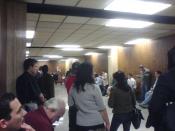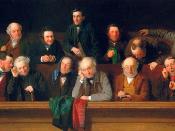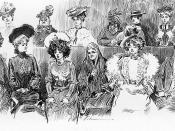Pretrial Publicity: Media Coverage and Guilt Attribution Abstract: This study was done to establish the effect that the media imposes on criminal trails. The media is the most influential part of our society. The media contributes to our thoughts, dress and attitudes. However the media can impose influence where it is not needed at times. For example, the media is able to influence a jury and stimulate a specific response to a case. The court system has struggled with the need to bar media influence from jurors and potential jurors. The bias that the media evoke usually represents community bias. Community bias directly influences pre-trial guilt attribution and therefore is detrimental to the justice system. However, since many have claimed that media poses little or no threat to pre-trial guilt attribution data was analyzed about five murder cases.
Method Richard A. Shaffer, a professor of Sociology at California Polytechnic State University, conducted the surveys and documented the findings.
The key concepts in the survey were: Pretrial publicity, information integration, juries, courts, guilt attribution, change of venue, media, trial, and jury selection. Pretrial publicity is the media representations of a case before trial begins. Information integration is when different medium covers a case. Guilt attribution is the assumption of probable guilt before the case is tried. Change of venue refers to the movement of a case to another location because of potential bias in the first location. Even though pretrial guilt is issue for the court scholars (Kaplan & Schersch, 1980) have stated that it can be overcomed by the instruction of the judge to disregard such information received from outside sources. However it was found that jurors still considered outside information during deliberations.
Procedure The first case involved a head librarian who was shot at a local state college. The shooting occurred on the campus' parking lot, the librarian died two days later. A father and son were arrested and charged with first-degree murder. 286 potential jurors were interviewed by phone. Change of venue motion was not met due to the confession of the defendant. The second case involved multiple crimes and multiple defendants. A man in his fifties was accused of molesting a ten years old girl and then hiring three others to kidnap and kill the girl for a $1,000. 266 potential jurors were interviewed by phone. Change of venue was approved. The third case was that of the three younger defendants in the second case. The case was represented in the media as an horrific crime. 416 potential jurors were chosen to be interviewed by the court. Change of venue was approved. The fourth case involved a woman and her live-in boyfriend who was accused of beating his girlfriend's two-year daughter to death. The beating was for disciplinary reasons.357 potential jurors were to be interviewed. Change of venue was granted. The fifth and final case centered on the killing of the owner of a "flea market". He was killed by one of his employees. The "flea market" owner was a successful businessman and well liked in the community. 399 people were contacted to be interviewed by the court. Change of venue was denied by the superior court and court of appeals.
Variables: Each case had the following variables as stated communication quarterly spring 1986 on page 160: NOTV: the number of times the potential jurors estimated seeing info. about the case on TV.
NORAD: the number of times the potential jurors estimated read info. about the case in the newspaper.
NOTALK: the number of times potential jurors had talked about the case with others.
TOTALNO: the total number of times the potential jurors estimated receiving info. from all sources.
GUILT: whether or not they thought the defendant was guilty.
PRBGUILT: whether or not they thought the defendant was probably guilty.
Newspapers were analyzed and it was found that almost all statements made were factual and less than ten percent of the headlines were false. The newspapers also summarized the case with every publication. Another set of variables were presented to specifically measure the impact of print media. The variables were: ARTOT: total number of articles written about the case in the newspaper.
ARTOT2:total number of articles in the newspaper within the two months the survey was conducted with the potential jurors.
FRTOT: total number of front- page articles written.
FRTOT2: total number of front -page articles within the two months prior to the survey with the potential jurors.
Result The test was designed to determine what aspect of the media had more influence than other aspects and if pre-guilt attribution can be associated with media coverage. The results were that the number of front page articles during the two months before the survey were the best predictors of guilt and probable guilt. The number of time the potential jurors remember seeing or hearing about the case was the second predictor of guilt attribution. The relationship between the TOTALNO and FRTOT2 showed that guilt attribution decreased as the number of articles increased. The case involving the two years old girl that was beaten had it's survey conducted while the woman was on trial (her boyfriend had a separate trial). There were seven front page articles about the case prior to the survey. The survey showed that 50% of the potential jurors thought she was guilty. Compared to the fifth survey, which involved the murder of the "flea market" owner. There were no front-page articles in the two month prior to the survey and therefore only 13% thought the defendant was guilty. The information derived from the variables only accounted for 9% of the guilt attribution. That leaves 90% of guilt attribution to be accounted for by other variables. These variables may include the brutality of the murder, the age of the victim, or the nature of other crimes combined with the murder.
Discussion The experiment showed that the courts cannot use the degree of media coverage of a crime to determine community bias. There are usually many more factors to be considered. I agree with the findings of the survey and would recommend that the court uses these findings to enhance the justice system. The survey was easy to understand as the variables were presented well. Richard A. Shaffer did a good job in presenting the method and findings of the survey. The survey should've included the race of the potential jurors and the race of the defendants in each of the cases. I think the race, sex and age of the individuals on both sides are important factors within a survey. Even though the media has a great influence in whether or not we attribute guilt to a person it's very important that we analyze a case with our own common sense. The media is a powerful source of bias so one has to have an open eye and mind and be very skeptical, when consuming media messages.
Works Cited Shaff, R.A. Pretrial Publicity: Media Coverage and Guilt Attribution, Communication Quarterly Vol.34, No.2, 1986, pp. 154-169





